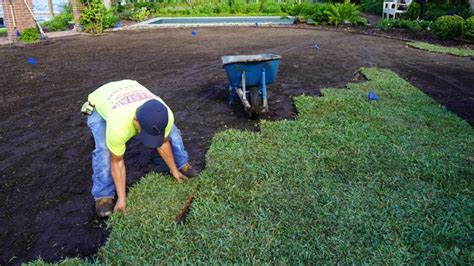St. Augustine Sod Installation: A Simple Guide to a Lush, Green Lawn
St. Augustine grass is a popular choice for homeowners in warmer climates due to its lush, green appearance and ability to tolerate heat and humidity. However, achieving a beautiful St. Augustine lawn requires proper installation. This comprehensive guide will walk you through each step, making the process simple and straightforward, even for first-time installers. We'll cover everything from preparation to maintenance, ensuring you have the knowledge to create the lawn of your dreams.
Preparing the Soil: The Foundation for Success
Before you even think about laying down the sod, preparing the soil is crucial. This step significantly impacts the health and longevity of your new lawn. Neglecting this phase can lead to uneven growth, weed infestations, and overall lawn failure.
1. Soil Testing: Start by conducting a soil test to determine its pH level and nutrient content. A balanced pH (around 6.0-6.5) and sufficient nutrients are essential for healthy St. Augustine growth. Your local agricultural extension office can often provide soil testing services.
2. Clearing the Area: Remove any existing vegetation, rocks, debris, and weeds. A thorough clearing ensures proper contact between the soil and the sod, preventing pockets of air that hinder root development.
3. Grading and Leveling: Level the soil to create a smooth, even surface. Uneven terrain can lead to water runoff and inconsistent grass growth. Use a rake and soil leveler to achieve a consistent grade.
4. Soil Amendment: Based on your soil test results, amend the soil with necessary fertilizers and organic matter like compost. This improves drainage, aeration, and provides essential nutrients for strong root establishment.
Choosing and Ordering Your St. Augustine Sod
Selecting high-quality sod is paramount. Look for sod that is vibrant green, free from weeds and disease, and has a dense root system. Order your sod from a reputable supplier who can guarantee freshness and timely delivery. Ensure you order enough sod to cover your entire area, accounting for some overlap.
How much sod do I need?
This is a frequent question. To calculate your needs, measure the area you intend to sod and add 5-10% extra to account for waste and overlap.
Installing Your St. Augustine Sod: A Step-by-Step Guide
With the soil prepared and sod ordered, it's time for installation. Remember, timely installation is key to the sod's success; it shouldn't sit for long before placement.
-
Laying the Sod: Begin laying the sod in straight lines, starting from one corner of your yard. Place each piece tightly together, ensuring there are no gaps. Stagger the seams, much like laying bricks, to create a strong, even lawn.
-
Cutting and Fitting: Use a sharp knife or sod cutter to cut the sod to fit around obstacles like trees, walkways, and flowerbeds.
-
Firmly Pressing: After laying each piece, firmly press it into the soil to ensure good contact. A roller can help achieve consistent soil contact across the entire area.
-
Watering Immediately: Water the newly installed sod immediately and deeply after completion. This helps the roots settle and prevents drying out. Continue to water regularly, keeping the soil moist but not soggy.
Maintaining Your New St. Augustine Lawn
Proper maintenance is vital for the long-term health of your St. Augustine lawn.
How often should I water my St. Augustine sod?
Watering frequency depends on weather conditions. Aim for deep, infrequent watering rather than shallow, frequent watering. This encourages deeper root growth.
How do I fertilize my St. Augustine grass?
Fertilize your lawn according to your soil test recommendations. Slow-release fertilizers are generally preferred to prevent burning.
What about pest and disease control?
Regularly inspect your lawn for pests and diseases. Address any issues promptly to prevent widespread damage.
Troubleshooting Common St. Augustine Sod Installation Issues
Even with careful planning and installation, problems can arise.
My St. Augustine sod is turning brown.
This could be due to inadequate watering, disease, or pest infestation. Investigate the cause and take appropriate action.
I have weeds growing in my new sod.
This can happen if the soil wasn't properly cleared before installation. Weed control measures may be necessary.
By following these steps and addressing potential issues promptly, you can enjoy a beautiful, healthy St. Augustine lawn for years to come. Remember, patience and consistent care are key to success.

